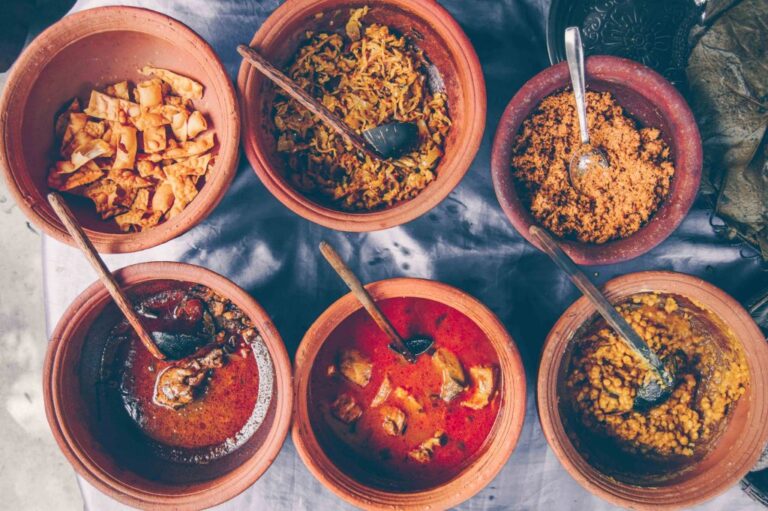A Taste of Sri Lanka: The Ultimate Guide to Experiencing Authentic Local Cuisine
A Taste of Sri Lanka: The Ultimate Guide to Experiencing Authentic Local Cuisine

Sri Lankan cuisine is a tantalizing blend of flavors, drawing from the island’s rich history, diverse cultures, and abundance of fresh ingredients. From spicy curries to sweet coconut-based desserts, each dish tells a story of the country’s heritage and the influence of neighboring regions like India, Malaysia, and the Maldives. This guide will introduce you to the must-try dishes and local experiences to fully immerse yourself in Sri Lanka’s vibrant food culture.
1. Rice and Curry – The Heart of Sri Lankan Cuisine
No visit to Sri Lanka is complete without trying the iconic rice and curry meal. Typically served with several side dishes, including dhal (lentils), sambol (a spicy coconut relish), and papadam (crispy fried crackers), this dish offers a balance of flavors, textures, and spices. Depending on the region, you may encounter different types of curry, ranging from fish and chicken to jackfruit and pumpkin.
2. Hoppers (Appa) – A Breakfast Delight
Hoppers, or appa, are a popular Sri Lankan breakfast dish made from a fermented batter of rice flour and coconut milk. These bowl-shaped pancakes are crispy on the edges and soft in the middle. One variation, egg hoppers, has a soft-cooked egg in the center, making it a delightful breakfast option. Pair your hoppers with lunu miris (a spicy onion relish) or curry for an authentic taste.
3. Kottu Roti – The Street Food King
Kottu roti is a favorite among locals and travelers alike. It’s a stir-fry of chopped roti (flatbread) mixed with vegetables, eggs, and meat (or tofu for vegetarians). The clanging sound of metal spatulas hitting the griddle is synonymous with Sri Lankan street food culture. It’s best enjoyed late at night from one of the many street vendors in cities like Colombo or Kandy.
4. Pol Sambol – A Coconut Sensation
Pol sambol is a simple yet flavorful condiment made from grated coconut, chili, lime, and onions. It’s the perfect accompaniment to almost any Sri Lankan meal, adding a burst of freshness and heat. Whether you’re having rice, roti, or hoppers, a spoonful of pol sambol is sure to elevate your dining experience.
5. Sri Lankan Sweets – A Must-Try for Dessert Lovers
If you have a sweet tooth, Sri Lanka’s traditional desserts won’t disappoint. Try kavum, a deep-fried rice flour cake, or wattalapam, a creamy coconut custard made with jaggery, cardamom, and cashews. Another favorite is kiribath (milk rice), which is often served during special occasions and festivals.
6. Tea – More Than Just a Drink
Sri Lanka is one of the world’s largest tea producers, and a visit to a tea plantation is a must for any tea lover. Sri Lankan tea, particularly Ceylon tea, is known for its rich flavor and aroma. While visiting the hill country, take a tour of a tea factory to learn about the production process and enjoy a freshly brewed cup with stunning views of the tea estates.
7. Where to Find Authentic Sri Lankan Food
While restaurants in tourist areas serve a range of dishes, for the most authentic experience, head to a local eatery, known as a “hotel” in Sri Lanka. These small establishments serve freshly made rice and curry meals, along with hoppers, kottu, and roti. Additionally, visiting a home-stay or joining a cooking class with locals can provide an even more intimate experience with Sri Lankan food culture.
Conclusion:
Exploring Sri Lanka through its food offers a unique insight into the island’s rich cultural tapestry. From street food to homemade delicacies, every dish is a testament to the diversity and complexity of Sri Lankan cuisine. So, whether you’re a foodie or just a curious traveler, make sure to savor the flavors of Sri Lanka during your visit.
Recent Posts
Top 7 Beaches in Sri Lanka for a Perfect Tropical Escape
A 10-Day Itinerary for First-Time Visitors to Sri Lanka
The Best Time to Visit Sri Lanka: A Month-by-Month Guide
Quick Booking Process
+94 77 645 1357



